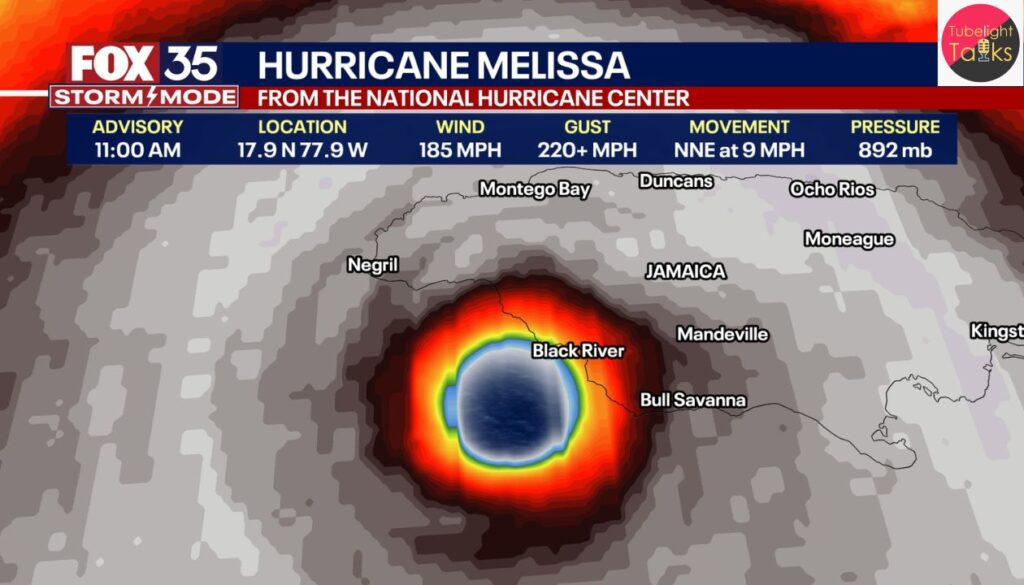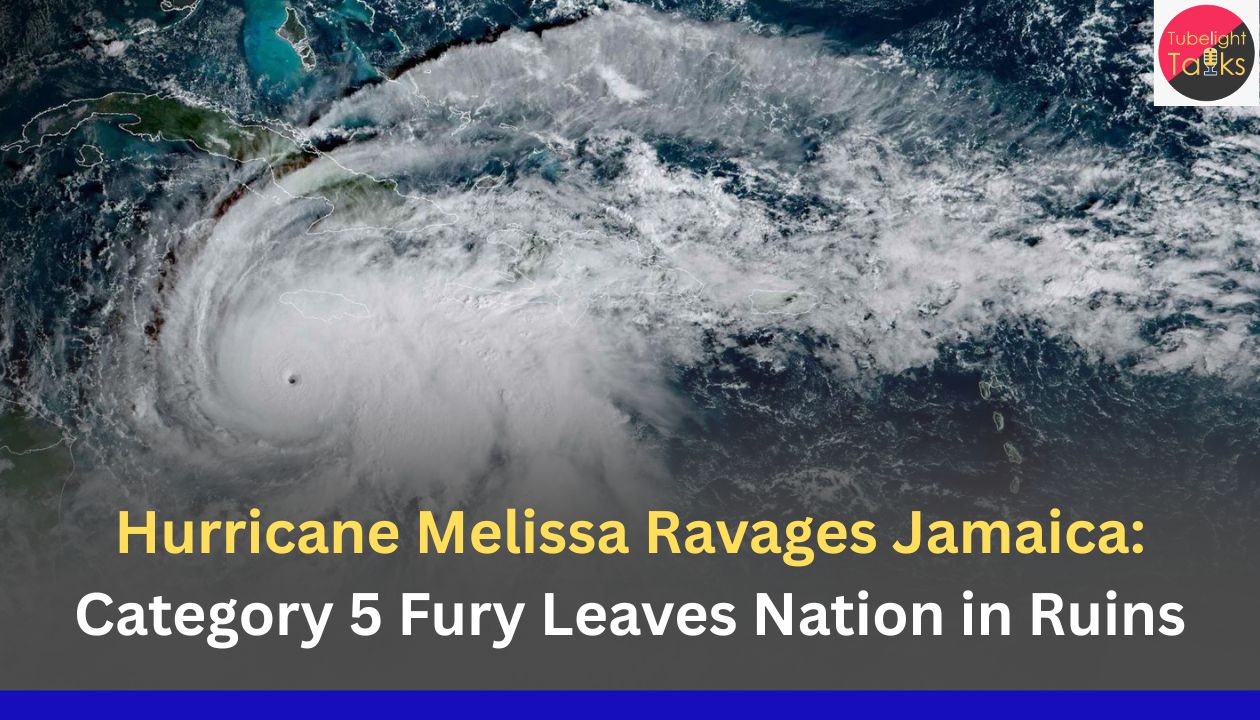Hurricane Melissa, a catastrophic Category 5 Atlantic storm, slammed into Jamaica on October 28, 2025, packing sustained winds of 185 mph (295 km/h) and unleashing torrential rains, deadly floods, and landslides. The unprecedented storm , the strongest to strike the island in 174 years, carved a diagonal path from St. Elizabeth parish in the south to St. Ann in the north, leaving millions without power and entire towns underwater. Officials warn of total building failures, massive displacement, and a recovery that could take years as Melissa now barrels toward Cuba with unrelenting force.
Key Takeaways: Hurricane Melissa’s Path of Destruction Across Jamaica
- Category 5 monster storm: Winds up to 295 km/h, gusts reaching 322 km/h in mountain regions.
- Historic impact: Strongest hurricane to hit Jamaica since recordkeeping began 174 years ago.
- Massive human toll: At least seven deaths reported , three in Jamaica, three in Haiti, and one in the Dominican Republic.
- Widespread outages: Over 240,000 power cuts and 25% of telecom services offline.
- 1.5 million people affected: Red Cross warns the “entire population may feel the impact.”
- Evacuations in Cuba: More than 200,000 people moved to safety in Holguín province and Banes.
- Unprecedented rainfall: Forecasts up to 40 inches in isolated Jamaican regions.
- Prime Minister’s appeal: “No infrastructure can withstand a Category 5. The question now is recovery speed.”
A Nation Under Siege: Jamaica Battles the Category 5 Onslaught
The storm roared ashore near St. Elizabeth parish, sweeping across central Jamaica before exiting near St. Ann parish. Winds up to 185 mph and driving rain turned bustling streets into rivers. In Kingston, the capital, roads stood empty except for a few hurrying pedestrians and a lone stray dog crossing floodwater-filled alleys.
Officials described it as a “worst-case scenario” — a disaster unmatched in living memory.
Meteorologist Michael Lowry confirmed that Melissa ranked as the fifth most intense Atlantic hurricane ever recorded, and the strongest since Hurricane Dorian (2019).
Michael Brennan, Director of the U.S. National Hurricane Center (NHC), issued a grim warning:
“It’s just a catastrophic situation playing out here for Jamaica. We expect total building failures.”
Government Efforts and Leadership Amid Chaos
As the storm bore down, Prime Minister Andrew Holness addressed the nation:
“There is no infrastructure in the region that can withstand a Category 5. The question now is the speed of recovery.”
Desmond McKenzie, Deputy Chairman of Jamaica’s Disaster Risk Management Council, implored citizens:
“Jamaica, this is not the time to be brave.”
Despite warnings, many families opted to stay home, terrified of losing property. Colin Bogle, a Mercy Corps adviser near Kingston, noted the widespread panic:
“Many have never experienced anything like this before, and the uncertainty is frightening.”
Rescue operations were mobilized even before landfall. “We have boats, helicopters, you name it,” McKenzie said, promising rapid deployment once conditions allow.
Power, Communication, and Health Systems Collapse
According to Transport and Energy Minister Darryl Vaz, over 240,000 households lost electricity, and one-fourth of the telecommunications network was knocked offline before landfall.
Coastal hospitals faced additional peril as a 13-foot (4-meter) storm surge threatened lower floors. Health Minister Christopher Tufton confirmed that patients were moved upstairs in preparation.
Meanwhile, Water Minister Matthew Samuda deployed 50 emergency generators and urged citizens to conserve supplies:
“Every drop will count,” he warned.
Heartbreaking Human Stories Amid the Storm
Beyond the statistics, Hurricane Melissa brought moments of deep human struggle.
A radio caller from western Jamaica pleaded for help for a woman in labor as winds intensified. With hospitals unreachable, an obstetrician called in live, offering detailed steps for emergency delivery.
Across Kingston, residents described terrifying noises, flying debris, and the sight of rooftops tearing away.
In a poignant account, Olympic champion Dawn Harper-Nelson and her husband Alonzo Nelson, trapped in St. Bran’s Burg during the storm, shared their ordeal:
“I’m just shocked. This is straight mayhem… I wasn’t ready, and this is just adding to the anxiety,” she said.
The couple had been in Jamaica for a business meeting when flights were grounded due to the hurricane. They later took shelter locally as power grids failed across the island.
Relief Efforts and Global Humanitarian Response
International relief agencies, including the United Nations and Red Cross, pre-positioned food, medical supplies, and sanitation kits in anticipation of post-storm devastation.
Red Cross regional head Necephor Mghendi estimated 1.5 million Jamaicans would face direct impacts, warning:
“The entire population may feel the impact one way or the other.”
UN agencies and NGOs prepared to launch emergency airlifts as soon as runways reopen. Airport authorities confirmed that debris clearance and safety tests are expected to start within 24 hours.
Also Read: Atlantic’s Chaotic Showdown: Cat 5 Humberto’s Swells and Imelda’s ‘Rain Bomb’ Threaten Coasts
Melissa’s Next Target: Eastern Cuba
Hurricane Melissa continued its deadly march toward Cuba, with forecasts projecting landfall in Holguín province late Tuesday or early Wednesday.
Authorities preemptively evacuated more than 200,000 people, while another 200,000 were earlier moved from the town of Banes.
Footage from state television showed blue-and-white buses carrying evacuees , families clutching babies, elders steadying themselves with canes, and belongings stacked on laps.
Cuban Deputy Prime Minister Eduardo Martínez, speaking from Banes, emphasized:
“This phenomenon is very dangerous. It is unprecedented.”
Meteorologists forecast up to 51 cm (20 inches) of rain and severe coastal flooding in the coming hours.
Impact Across the Caribbean
Melissa has also lashed southern Haiti and the Dominican Republic, triggering landslides and flash flooding. A tropical storm warning remains active in Haiti.

As the hurricane advances, forecasters predict a turn toward the northeast, placing the southeast Bahamas in its potential path by Wednesday evening.
A Nation in the Aftermath: The Long Road Ahead
As Jamaica faces its darkest hour, the nation stands resilient. Relief operations are mobilizing, and the global community has pledged support.
Prime Minister Holness reaffirmed his government’s commitment to rapid restoration of infrastructure and essential services. Yet, the damage assessment, rescue missions, and emotional toll will take time to heal.
The storm has tested not only buildings but the spirit of an island known for its strength. In the coming days, the world will watch Jamaica’s courage rise from the wreckage left behind by Hurricane Melissa, the most powerful storm in its modern history.
Divine Protection Through True Devotion and the Humanitarian Service
Natural disasters like Hurricane Melissa remind us that even the strongest structures and technologies are powerless before nature’s fury. Yet, those who walk on the path of true devotion and please the Supreme God remain under His divine protection. When we connect with the Almighty through scripture-based devotion (Shastra-Anukool Bhakti), He prevents calamities before they strike and saves His devotees from danger.
Tatvdarshi Sant Rampal Ji Maharaj Ji has often explained that if we truly surrender to God and live in His discipline, the Almighty shields us just as He once protected a tiny bird during the great Mahabharata war. The Supreme God listens to every cry, of birds, animals, and humans alike. If He could save a bird amid battle, why would He not protect His devotees who follow His true path with faith and purity?
Recently, the compassionate spirit of Jagatguru Tatvadarshi Sant Rampal Ji Maharaj Ji is once again evident when devastating floods struck hundreds of villages in Haryana. While government relief efforts struggled and many organizations failed to respond on time . Under the divine guidance of Sant Rampal Ji Maharaj Ji, His followers reached the flood-affected regions through the Annapurna Muhim, delivering crores worth of essential relief materials including food, clean drinking water, motors, and pipes to hundreds of devastated villages. Even while residing in Jail Dham, Sant Rampal Ji Maharaj Ji inspired His disciples to lead these humanitarian efforts , making Him the only Saint who came forward selflessly when no one else did.
This selfless service is a living example of divine compassion and true devotion in action. It shows that when we live under the guidance of a Tatvdarshi Saint, not only are we spiritually protected, but we also become instruments of God’s mercy in helping others.
Therefore, to attain peace, protection, and liberation (moksha), every soul must seek the refuge of a True Saint and follow the path of Sat-Bhakti (True Devotion). When we make the Supreme God happy through our faith and righteousness, such disasters lose their power, and our lives become filled with divine grace.
For authentic spiritual guidance and to understand the true path of devotion, visit: www.jagatgururampalji.org
FAQs on Hurricane Melissa 2025: Jamaica and Cuba Devastation
1. What category is Hurricane Melissa 2025?
Hurricane Melissa is a Category 5 storm with sustained winds of 185 mph (295 kph), making it one of the strongest Atlantic hurricanes in history.
2. Which areas were worst affected by Hurricane Melissa?
Jamaica faced catastrophic winds, flooding, and landslides, while eastern Cuba braced for heavy rain and storm surge after mass evacuations in Holguín and Banes.
3. How many casualties were reported from Hurricane Melissa?
At least seven deaths were reported — three in Jamaica, three in Haiti, and one in the Dominican Republic, with one person still missing.
4. What did Jamaica’s Prime Minister say about the storm?
Prime Minister Andrew Holness stated that no infrastructure can withstand a Category 5 hurricane and emphasized that recovery speed will be the main challenge.
5. What’s next in Hurricane Melissa’s path?
After striking Jamaica, Hurricane Melissa is expected to move toward eastern Cuba, bringing up to 51 cm of rain, and later target the southeast Bahamas.










